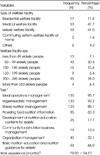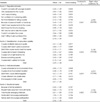Abstract
Objectives
This study analyzed the education participation reasons and deterrents of dietitians who work in welfare facilities for the elderly.
Methods
The survey was completed by 144 dietitians working at welfare facilities for the elderly in Korea. The survey was conducted in October, 2018, both on-line and off-line, based on the demographic characteristics, work status on welfare facilities for the elderly, Participation Reasons Scale (PRS) and Deterrents to Participation Scale (DPS-G). The data were analyzed using frequency analysis, descriptive analysis, factor analysis, reliability analysis, regressive analysis using SPSS ver. 25.0.
Results
The reason for participation were divided into three factors: ‘Responsibility of professional and self-development (5.76 ± 1.04)’, ‘Job stability and personal benefits (4.98 ± 1.28)’, and ‘Interaction and development of professional competencies (5.85 ± 1.00)’. ‘Interaction and development of professional competencies’ was the highest motivation factor. Also, the deterrents for participation were divided into four factors: ‘Dispositional barrier (2.70 ± 1.29)’, ‘Dissatisfaction of education usability (3.39 ± 1.38)’, ‘Institutional barrier (4.21 ± 1.45)’, and ‘Situational barrier (2.36 ± 1.30)’. ‘Institutional barrier’ showed the highest deterrents factor. In addition, ‘Responsibility of professional and self-development’ and ‘Interaction and development of professional competencies’ were negative attributes for ‘Dispositional barrier’ (p<0.001).
Figures and Tables
Acknowledgments
This research was supported by a grant from the Korea Federation of Women's Science & Technology Association.
References
1. Ministry of the Interior and Security. Resident population and household status [internet]. Ministry of the Interior and Security;2018. cited 2019 Apr 04. Available from: http://27.101.213.4/#.
2. Kang HS, Lee Y, Chae IS. Job importance, job performance, and job satisfaction in dietitians at geriatric hospitals or elderly healthcare facilities in Jeju. J Nutr Health. 2016; 49(3):189–200.

3. Kim SU. Risk and social conflicts in ultra-low birth rate and super aged society. Korea Institute for Health and Social Affairs;2014. 12. Report No. 2014-22-1-7.
4. Kim JS. Customized food and meal service for the elderly: Its management and policy implications. Health Welf Forum. 2018; 264:57–69.
5. Seo EH, Park EJ. Nutrition intake status of the elderly in residential welfare facilities by dietitian employment. J Korea Soc Wellness. 2016; 11(4):473–483.

6. Han GS, Yang EJ. Status of foodservice operations in long-term care facilities for the elderly: Focus on the Gwangju metropolitan city. J East Asian Soc Diet Life. 2018; 28(5):337–344.
7. Hong SY, Seo SH. Job performance frequency and the training needs of dieticians in elderly healthcare facilities. J Korean Diet Assoc. 2010; 16(2):160–177.
8. Cervero RM. Trends and issues in continuing professional education. New Dir Adult Contin Educ. 2000; 2000(86):3–12.

9. Sohn CM, Cho YY, Bea MY, Do EK, Na WR, Kim MS. Analysis of reasons for continuing education in dietitians. J Korean Diet Assoc. 2013; 19(4):416–423.

10. Murphy C, Cross C, McGuire D. The motivation of nurses to participate in continuing professional education in Ireland. J Eur Ind Train. 2006; 30(5):365–384.

11. Han SM, Lee HS. Nurses' reasons for participation in continuing nursing education. J Vocat Educ Res. 2010; 29(2):189–204.
12. Houle CO. Continuing learning in the professions. Mobius: A. J Contin Educ Prof Health Sci. 1981; 1(1):76–80.
13. Grotelueschen AD. Assessing professionals' reasons for participating in continuing education. New Dir Contin Educ. 1985; 27:33–45.
14. Desilets LD. Assessing registered nurses' reasons for participating in continuing education. J Contin Educ Nurs. 1995; 26(5):202–208.

15. Aucoin JW. The comparison in participation in continuing nursing education between certified and non-certified staff development specialists. [master's thesis]. Louisiana State University Medical Center;1997.
16. Hayajneh F. Attitudes of professional Jordanian nurses toward continuing education. J Contin Educ Nurs. 2009; 40(1):43–48.

17. Han EM. Participation motivation of adult learners in piano education, barriers to their piano education and their educational needs [master's thesis]. Chung-Ang University;2011.
18. Chio US. An analytical study on conditions and nature of adult learners' participation for lifelong education. J Lifelong Learning Soc. 2006; 2(1):1–35.
19. Doray TE. Testing the universality of the generic deterrents to participation scale, Dps-g: a case study [dissertation]. Oklahoma State University;1990.
20. Cross KP. Adult learners: Characteristics, needs and interests. In : Peterson RE, editor. Lifelong learning in America. Sanfrancisco: Jossey-Bass;1979.
21. Muse CT. Cost benefit analysis, traditional vs. adult students. J Stud Finan Aid. 1979; 9(3):22–27.
22. Isaac EP. Barriers to adult education participation, distance education, and adult learning. Encycl Info Commun Tech Adult Educ Integr. 2011; 1100–1112.

23. Darkenwald GG, Valentine T. Factor structure of deterrents to public participation in adult education. Adult Educ Q. 1985; 35(4):177–193.

24. The Korean Dietetic Association. Education information page [internet]. The Korean Dietetic Association;2019. cited 2019 Apr 9. Available from: https://www.dietitian.or.kr/work/education/ke_curefood_info.do.
25. Shin KE. A study on dietitian's job status at the elderly welfare facilities [master's thesis]. Daejin University;2007.
26. Park HH, Lee KW, Kim SO. A study on the participation motivation of clinical nurses in job training. J Digit Converg. 2016; 14(8):319–329.

27. Kwak YS, Han MJ. Study of the job satisfaction and characteristics of dietitians working in the elderly health care facility. J Korean Soc Food Cult. 2012; 27(6):677–685.

28. Bae HJ, Lee HY, Chun HJ. An assessment of dietitian job tasks according to the characteristics of foodservice operations and dietitians. Korean J Food Cookery Sci. 2007; 23(6):858–866.




 PDF
PDF ePub
ePub Citation
Citation Print
Print










 XML Download
XML Download